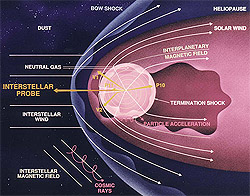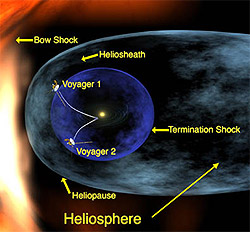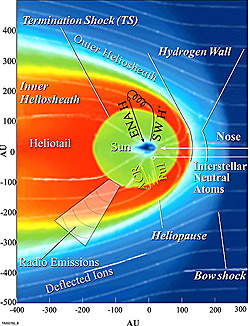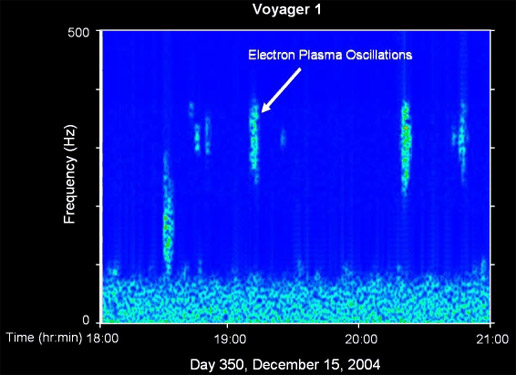The sun's solar wind eventually fills space with an enormous bubble of gas called the heliosphere. Scientists are still searching for its outer limits - the heliopause.
ISSUE #62: Where is the Heliopause?

Figure 1: A diagram of some of the main components of the heliosphere. (Courtesy - NASA Interstellar Probe).
The solar wind is a dilute gas, called a plasma emitted by the sun that flows past the planets into interstellar space. Interstellar space, however, has its own dilute plasma called the interstellar medium. The collision between these two plasmas produces a pressure boundary called the heliopause. This boundary cannot be detected from Earth, but must be identified from in situ measurements. Currently, NASA's two working spacecraft, Voyager 1 and 2 are poised to make contact with the heliopause, and travel beyond it into the interstellar medium. At exactly what distance this will happen is not known precisely.
History:

Figure 2: This is a 'scary' diagram showing the regions of the heliosphere (click on image for larger view). There really isn’t any fire-like cloud ramming into the heliosphere! It also shows the approximate locations of Voyagers 1 and 2. Voyager 1 is traveling faster and has crossed into the heliosheath. (Courtesy: NASA / Walt Feimer).
In 1955, British physicist Sydney Chapmen concluded that, because the sun's corona was so hot (several million degrees), it must also exist beyond the orbit of Earth. This region came to be known as the heliosphere. A few years later, Eugene Parker at the University of Chicago showed, mathematically, that an expanding, supersonic, hot corona would produce a solar wind that exactly accounts for comet tail deflections.
Much of the early discussions about the heliosphere were the result of cosmic ray studies. In 1956, studies of cosmic ray energies by Philip Morrison (1915-2005) at Cornell led to the realization that Earth had to be immersed in a region of tangled interplanetary magnetic field of solar origin. Leverett Davis at Caltech, and Meyer at the University of Chicago concluded from their studies that a good fit to the data would obtain if the cavity were about 200 AU in diameter. Hannes Alfven (1957) later introduced the notion of an interplanetary magnetic field carried along with the solar wind.
The region where the solar wind encounters the interstellar medium is a complicated zone that is in rough pressure balance. The pressure of the expanding 'supersonic' solar wind pushes against the interstellar medium through which the solar system is passing, which is exerting its own pressure. The two pressures (heliosphere and interstellar medium) come, not from the temperatures of the two gasses, but mostly from their density and rate of motion much like the plowing of a boat across the water leaves a 'bow wave' ahead if it.
As we leave the solar system behind, this pressure front between the two plasmas consists of:
- Termination Shock, where the supersonic solar wind is slowed down rapidly. This is the nearest zone to the sun, and the first indication to a spacecraft that it is about to pass through the heliosphere's outer boundary.
- Heliosheath Region, a broad middle zone beyond the Termination Shock where the outflowing plasma from the solar wind is diverted and flows back towards the solar system along the heliospheric tail.
- Heliopause, where the solar wind and interstellar medium pressures are in equilibrium.
- Bow Shock. This is the zone where the interstellar medium slows down drastically as it senses the obstruction of the heliopause 'ramming' its way through the interstellar gases.

Figure 3: This is a diagram that shows the different parts of the heliosphere. As the Sun moves through the interstellar medium, the material around it is "pushed" out of the way by the solar wind, which forms the heliosphere. Each part of the heliosphere has a different name, as indicated on the diagram: the bow shock, heliopause, heliosheath, termination shock, and the heliotail. (Courtesy: NASA-IBEX).
While interstellar plasma is kept outside the heliosphere by the interplanetary solar magnetic field, the interstellar neutral gas flows through the solar system like an interstellar wind, at a speed of 25 km/sec. The neutral atoms become ionized, and are eventually dragged back out to the Termination Shock. The ions repeatedly collide with the termination shock, gaining energy in the process. This continues until they escape from the shock and diffuse toward the inner heliosphere. Those that are accelerated are then known as anomalous cosmic rays (ACRs). ACRs are thought to represent material from the local interstellar medium, and have been detected by NASA satellites for several decades.
And the answer is…
Pioneer 10 -
This probe became the first artifact to "leave the Solar System" on June 13, 1983 when it passed beyond the orbit of farthest known planet. In 1997, Pioneer 10 was over 6 billion miles away with round-trip communications taking over 18 hours at the speed of light of 186,000 miles per second! Pioneer 10 searched for the solar wind termination shock and the edge of interstellar space, but no firm detections were reported.
Voyager 1 -
The Voyager 1 space probe crossed the Termination Shock on December 16, 2004 at a distance of 13.8 billion kilometers (94 AU) from the Sun. The spectrogram of the plasma signals marking this event is shown in Figure 4. The termination shock is believed to be about 6 billion kilometers inside the heliopause, so it expected that by 2017 Voyager 1 will arrive there, and soon afterwards be in the heliopause. Once Voyager 1 is on the other side of the heliopause, it will be in the zone where interstellar gas and magnetic fields are the main ingredient and officially entering interstellar space for the first time.
Voyager 2 -
Voyager 2 has been flying out of the solar system in a different direction than Voyager 1. At a distance of 12.3 billion kilometers (84 AU), NASA's Voyager 2 probe crossed the solar-wind termination shock on Aug. 30, 2007 which is 30 years and 10 days after the spacecraft launched from Cape Canaveral, Fla.
Voyager 2 has found that the termination shock is about 1.5 billion kilometers closer to the sun than Voyager 1 did in the north. Voyager scientists think this is caused by an interstellar magnetic field pressing against the heliosphere preferentially in the south. Voyager 2 may reach interstellar space within another few years, perhaps before the Voyager 1 gets there in 2017!

Figure 4: Frequency-time spectrogram showing plasma oscillations preceding termination shock crossing by Voyager 1. (Courtesy NASA/Voyager).
Credits:
Dr. Alan Cummings (Voyager / CRS)
Dr. Sten Odenwald (Author - Hinode)
GALLERY
REFERENCES
Voyager - http://voyager.jpl.nasa.gov/news/tenthop.html
NASA Press Release - http://www.nasa.gov/centers/goddard/news/topstory/2007/dragon_fire.html
2008 ISSUES
- #63: Eclipse
- #62: Where is the heliopause?
- #61: What causes and Auroral Storm?
- #60: Where does the Sun's magnetic field come from?
- #59: Where did all the Neutrinos go?
- #58: Why is the Sun's Corona Hot?
View past issues
Space Weather Fact
The core of the sun is nearly as dense as lead, and has a temperature of 15 million °C.




